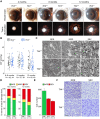This is a preprint.
TLR4 deficiency does not alter glaucomatous progression in a mouse model of chronic glaucoma
- PMID: 38895321
- PMCID: PMC11185798
- DOI: 10.1101/2024.06.07.597951
TLR4 deficiency does not alter glaucomatous progression in a mouse model of chronic glaucoma
Update in
-
TLR4 deficiency does not alter glaucomatous progression in a mouse model of chronic glaucoma.Sci Rep. 2025 May 15;15(1):16852. doi: 10.1038/s41598-025-00638-7. Sci Rep. 2025. PMID: 40374644 Free PMC article.
Abstract
Glaucoma is a leading cause of irreversible blindness worldwide. Toll-like receptor 4 (TLR4) is a pattern-recognition transmembrane receptor that induces neuroinflammatory processes in response to injury. Tlr4 is highly expressed in ocular tissues and is known to modulate inflammatory processes in both anterior and posterior segment tissues. TLR4 activation can lead to mitochondrial dysfunction and metabolic deficits in inflammatory disorders. Due to its effects on inflammation and metabolism, TLR4 is a candidate to participate in glaucoma pathogenesis. It has been suggested as a therapeutic target based on studies using acute models, such as experimentally raising IOP to ischemia-inducing levels. Nevertheless, its role in chronic glaucoma needs further evaluation. In the current study, we investigated the role of TLR4 in an inherited mouse model of chronic glaucoma, DBA/2J. To do this, we analyzed the effect of Tlr4 knockout (Tlr4 -/-) on glaucoma-associated phenotypes in DBA/2J mice. Our studies found no significant differences in intraocular pressure, iris disease, or glaucomatous progression in Tlr4 -/- compared to Tlr4 +/+ DBA/2J mice. These data do not identify a role for TLR4 in this chronic glaucoma, but further research is warranted to understand its role in other glaucoma models and different genetic contexts.
Conflict of interest statement
Competing interests The authors declare that they have no competing interests.
Figures

Similar articles
-
TLR4 deficiency does not alter glaucomatous progression in a mouse model of chronic glaucoma.Sci Rep. 2025 May 15;15(1):16852. doi: 10.1038/s41598-025-00638-7. Sci Rep. 2025. PMID: 40374644 Free PMC article.
-
Early pro-inflammatory cytokine elevations in the DBA/2J mouse model of glaucoma.J Neuroinflammation. 2015 Sep 17;12:176. doi: 10.1186/s12974-015-0399-0. J Neuroinflammation. 2015. PMID: 26376776 Free PMC article.
-
Determining immune components necessary for progression of pigment dispersing disease to glaucoma in DBA/2J mice.BMC Genet. 2014 Mar 28;15:42. doi: 10.1186/1471-2156-15-42. BMC Genet. 2014. PMID: 24678736 Free PMC article.
-
AIBP: A New Safeguard against Glaucomatous Neuroinflammation.Cells. 2024 Jan 21;13(2):198. doi: 10.3390/cells13020198. Cells. 2024. PMID: 38275823 Free PMC article. Review.
-
The use of benzalkonium chloride in topical glaucoma treatment: An investigation of the efficacy and safety of benzalkonium chloride-preserved intraocular pressure-lowering eye drops and their effect on conjunctival goblet cells.Acta Ophthalmol. 2023 Dec;101 Suppl 278:3-21. doi: 10.1111/aos.15808. Acta Ophthalmol. 2023. PMID: 38037546
References
Publication types
Grants and funding
LinkOut - more resources
Full Text Sources
